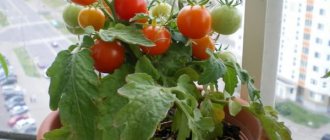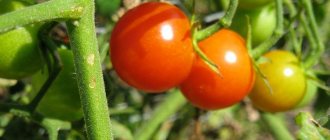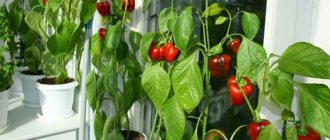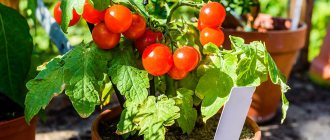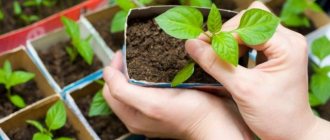Hello again, my dear readers. Today I want to share with you the subtleties and nuances of growing tomatoes on the balcony. It’s a rewarding thing when you get tomatoes at a time when they are only available at the market, and they are so fresh that you can’t put them in your mouth. So hurry up to plant seedlings and grow the sweetest tomatoes on your balcony.
By the way, I recently wrote articles about growing tomatoes in a greenhouse and in open ground. There are a lot of useful things there too, so don't miss them. I recommend it.
Read the article to the end so as not to miss not only the rules for growing seedlings, but also further care. Don't forget about pinching, tying and feeding! This is almost the most important thing).
Features of growing tomatoes on the balcony
Growing tomatoes and caring for them in an apartment is not much different from growing them in open ground and caring for indoor plants. But there are also some peculiarities. Breeders have developed a large number of tomato varieties specifically for growing indoors. If you want to grow tomatoes on a windowsill, it is better to choose low-growing varieties, for example, Florida Petite (Little Florida) and Oak. Outdoors, plants grow 25-35 cm tall. In the room they stretch up to 40-50 cm, but their trunk is strong enough and there is no need to tie up the plants.
Florida Petite
They are distinguished by their compact bush size and high decorative value. The fruits on them are small in size, but very tasty. And due to the fact that there are a lot of them on each bush, the harvest is quite decent. Also, such low-growing varieties as “Pinocchio”, “Balcony Miracle”, “Button”, “Bonsai”, “Mikron NK”, etc. have proven themselves well.
Pinocchio
Balcony miracle
If you have a large, well-lit balcony or loggia, then you can try planting large-fruited and tall varieties: “Bull’s Heart”, “Slivka”, “De Barao”, “White Naliv”, “Carlson”. But in this case, we must take into account that one such bush requires at least 10-15 liters of soil. Also suitable are “Semko-98 F1”, Ground Gribovsky 1180, Leningradsky early ripening, Peremoga 165, Pervenets 190, as well as: De Barao, Bushtomaten, Pear-shaped cream, Sonata, “Max”, “Caspar F1”, “Gina”, White pouring and Siberian early ripening.
De Barao
Bushtomaten
Tomatoes are a light-loving crop. Northern balconies are unsuitable for growing them. South-eastern ones are ideal. It is very hot on the southwestern balconies in the summer heat. It is necessary to think over a system of shading and ventilation. Although many gardeners claim that tomatoes grow well on septic balconies. The main thing is that the sun appears for at least 4 hours a day.
Variety selection
For small balconies or window sills, you need low-growing and dwarf tomatoes (Malysh, Dubok). They are distinguished by juicy fruits and their large quantity.
There are a number of other reasons to choose these varieties:
- For planting you need a small container: 3-3.5 liters.
- A small root system better absorbs nutrients from the soil.
- Easy to care for, as the bushes do not require tying up.
- Early ripening. The first harvest is harvested after 80-95 days.
Many varieties stop growing after the fruit clusters are formed. If you want to grow bushes to decorate a window, cherry tomatoes are perfect, no higher than 40 cm. The fruits are small, weighing 15-70 g. They are used for beautiful serving of dishes or salads. The quantity per bush is 1-2 kg. Representatives: Mikron, Bonsai.
Standard varieties with a thick, erect stem around which a crown is formed are often chosen. They have high productivity. The number of fruits on one branch reaches 20 pieces.
To get a large harvest, choose tall varieties with a large spreading crown. Representatives: Citizen, Garden Pearl.
If there is a lot of space, bushes with large fruits are grown: Ox's heart or White filling.
General characteristics of some varieties:
| Variety name | Bush height (cm) and ripening time (days) | Shape, color, taste, fruit weight | Features of care |
| Bonsai micro | 15. 80. | Round, red, sweet. | Compact and unpretentious. |
| Garden pearl | 15-20. 85-93. | Red with a raspberry tint, sweet. | Needs to be tied up. |
| F1 Balcony red | 30. 85. | Bright red, sweet. | Easy to care for. |
| Pinocchio | 30. 95-100. | Red spherical, sweet. | Ideal for growing on a windowsill. |
| Balcony duet | 35. 76. | Red, sweet. | The bush does not take up much space. |
| Balcony miracle | 35-45. 90. | Bright red, juicy, sweet. | Easy to care for. Does not require tying. |
| Angelica | 50-70. 80-95. | Deep red, sweet. | Not demanding on formation. Treatment for diseases is required. |
| Red pearl | 50. 85-100. | Bright red, sweet, fleshy. | Does not require stepsoning. |
| Butterfly | 150. 110-120. | Raspberry-red, sweet. | Needs to be tied up. |
| Ballerina | 150-180. 100-105. | Bright pink, sweet. | Does not require tying. |
| Bonsai | 30. 85. | Round red, sweet with sourness. | Easy to care for. |
| Minibel | 40. 82. | Unpretentious to lighting and soil. | |
| Philippok | 40. 94. | Doesn't need tying. | |
| Balconies Yelou | 45. 100-110. | Round yellow, sweet with sourness. | Compact bush. |
Planting tomatoes
To plant tomatoes, you can use one of the soil mixtures:
- Ready-made soil substrate "Exo".
- Ready-made soil mixture “Tomato and pepper”.
- 1 part turf soil, 1 part peat, 1 part humus. It is better to take humus from dung.
- 2 parts of leaf soil (from a forest plantation), 1 part of peat (Can be bought in a store) and 1 part of clean sand.
- 4 parts turf or good garden soil + 4 parts humus (compost) + 1-1.5 parts vermiculite.
Add 1 glass of ash and 1 tablespoon of nitroammophoska (nitroammophoska). If they take purchased peat soil instead of humus, then they do not add mineral fertilizers, they are already there.
A 3 cm thick layer of clean washed gravel or red brick chips is poured into a clay pot with a capacity of 3 liters, and a prepared, slightly compacted mixture is poured on top so that approximately 2 cm of the container from above is not covered with earth. The mixture is spilled with a pink hot solution of potassium permanganate or boiling water (for disinfection). To enrich the soil with minerals, it is better to add sifted charcoal.
In order for seedlings to appear faster, the seeds must be pre-soaked. To do this, you need to place them in a pale pink solution of potassium permanganate for 20 minutes (10 g/1 l of water). Then throw away those that did not sink to the bottom, and take out the rest, wrap them in a wet cloth and wait for them to hatch. If the manufacturer has applied a special protective and nutritious film to the planting material, there is no need to soak it.
To sow seeds, you can use 200 ml plastic cups. It is advisable to choose transparent cups so that you can control the watering. You should not make holes for water at the bottom, since if the volume is small, the soil will not have time to absorb a sufficient amount of water.
The glass must be filled with earth, leaving about a finger's worth of free space at the top. Make a hole 2 cm deep, plant 2 grains, fill the hole with soil. After this, the glasses should be covered with plastic wrap to prevent moisture evaporation and placed in a dark place with a temperature of 24-26°C.
On the third or fourth day, as soon as the first shoots appear, transfer the crops to a cool windowsill with artificial lighting so that the seedlings do not stretch out too much, and do not water until the top layer of soil dries out to avoid the development of fungal diseases.
Fungal diseases, the emergence and spread of which is facilitated by dampness, pose a great danger to tomatoes. The development of the disease is prevented by sunlight and free access to fresh air.
A good way to combat plant diseases is spraying with Bordeaux mixture. To prepare it, you need to dissolve 10 g of copper sulfate in a glass container in 0.9 liters of water, and dilute 20 g of slaked lime in 0.1 liter of water. Pour the milk of lime in a thin stream into the vitriol solution, stirring continuously. The finished mixture is stored for no more than 24 hours.
When two or three “real” leaves appear, transplant the tomatoes into larger pots. For dwarf tomatoes, a container with a volume of 4-5 liters will be enough, but the more space, the better. Place expanded clay or pieces of polystyrene at the bottom of the pot, add a 2-3 cm layer of sand and a little soil. Lightly water the seedlings, and then carefully remove them from the glass along with a lump of earth. Place the seedling in a pot and fill the free space with soil. If more than one sprout has grown, it is better to leave one of the healthiest ones and pinch off the rest with your hands at the root. Add 2-3 cm of soil on top and water. Thus, there should be 5-7 cm free in the pot to the top edge. This will make it possible to add soil to the pot as the plant grows, thereby replacing hilling.
Comprehensive care for tomatoes
Living conditions for tomatoes grown on the balcony should differ minimally from their natural habitat. Growing vegetables involves watering, fertilizing, loosening the soil, maintaining the required temperature, and pollination.
Temperature
Tomatoes on the balcony are very sensitive to temperature fluctuations, and when it drops below 18 degrees, growth slows down. It is also necessary to monitor humidity, since excessive humidity is detrimental to tomatoes: the plants begin to wither and are likely to contract fungal diseases. The room needs to be ventilated periodically: the windows can be left open for a long time when it’s warm outside, and in the summer they don’t need to be closed at all.
Watering
Irrigation should be carried out regularly as soon as the soil dries out. Simple tap water is suitable for irrigation, but drinking water can be used. Vegetables growing on the balcony should be supplied with moisture much less frequently than for ground tomatoes. Everything will depend on the degree of soil moisture.
Watering should be moderate until the plants bear fruit, and when the harvest begins, it is better to irrigate the plantings less often. Drier soil results in faster fruit ripening.
Pollination
Tomato is a self-pollinating plant. In some cases, parthenocarpic formation of fruits is possible, that is, without fertilization. There are varieties that bear seedless fruits. In any case, tomatoes on the balcony do not need bees or other insects to set fruit.
Loosening
In order for the roots to grow and strengthen, it is very important to provide them with access to oxygen. Often, after watering, a crust forms on the surface of the earth, which prevents air from entering the soil. To do this, loosening is carried out. It is important to start fluffing up the soil when the water has been absorbed and the soil has dried out. It is convenient to loosen with a garden tool with three teeth on a short handle. Do not touch the soil 5 cm around the stem, so as not to injure the root.
If loosening is inconvenient or impossible for you, mulch the soil with peat. This composition prevents the formation of a crust on the soil surface and reduces the amount of moisture evaporation.
Top dressing
Undoubtedly, the best fertilizer for vegetables is an organic composition. But in a city apartment this is unlikely to be realistic, because natural products have a very unpleasant odor. Therefore, tomatoes growing on the balcony can be fed with mineral fertilizers. The water-soluble fertilizer Fertik has proven itself well. If you can use Fertika Start when the seedlings are old, then Fertika Universal is suitable for adult plants.
Do not overfeed the tomatoes on the balcony with fertilizers, because this will not lead to anything good. Proceed based on the manufacturer's recommendations - dilute the composition in the required proportions, and then there will be no problems.
Stepsoning
As the bushes grow, shoots form in the axils of the leaves. They have no practical value, but only draw out all the juices from the plant and reduce the yield. Therefore, it is important to remove the shoots as soon as they extend 2 cm. You just need to break them off with your hands and pour wood ash onto the affected area to disinfect it.
It is recommended to carry out pinching during the growing season. In addition to the shoots, you need to break off the lower leaves that lie on the soil. By freeing up space under the bush, you will provide the bush with air flow and disease prevention.
Watering seedlings
Seedlings are watered quite rarely, about once every 8-10 days. The soil in the pot should always be constantly moist. Water for irrigation is kept at room temperature. The air temperature for seedlings is maintained at the following level: during the day - +18...+22 degrees, and at night - +15...+16 degrees. If it gets too warm during the day, open the window. At the same time, make sure that the flow of cold air does not fall on the seedlings. Sometimes they cover them with film for this, and sometimes they simply put a plywood shield.
Necessary conditions for cultivation
Tomatoes are very unpretentious to grow and do not require much:
- light;
- warm;
- moisture;
- fertile land.
It is enough for tomatoes to be in the light 17 hours a day . If the bushes begin to stretch out and the root system develops poorly, it means that the plants do not have enough sun. To solve this problem, you can buy a special lamp in the store.
Important! Constant sunlight is detrimental to most tomato varieties.
Tomatoes do not require too high an air temperature . During the day, 22–26 °C is enough for them, and at night they feel comfortable at a temperature of 16–19 °C. Overheating and hypothermia of plants will lead to their death or to the fact that they will not bear fruit. That is why it is important to maintain the temperature regime on the balcony. Humidity should not exceed 85% and it is undesirable for it to fall below 65%.
Lighting
Tomatoes are very demanding on lighting. To avoid using artificial lighting, it is better to plant seeds in late March - early April, and place the plants in the south or southeast. For uniform lighting, once every two days you can turn the tomatoes with the other side towards the window.
On cloudy short winter days, it is simply impossible to grow lush bushes in an apartment without additional lighting. It is no secret that light is the main component of the process of photosynthesis, which is important for a plant, without which normal growth and development of the plant does not occur.
Additional lighting of tomato seedlings
You can organize additional lighting using fluorescent lamps of white and daylight. These lamps provide sunlight-like illumination without generating heat. Therefore, they can be placed quite close to the plants. Also, in specialized stores you can purchase phytolamps adapted specifically for indoor growing of vegetables.
Problems of growing indoor tomatoes - pests and diseases
To ensure a bountiful harvest, tasty fruits, and beautiful bushes, you need to carefully care for the plants. This will prevent the development of diseases and the appearance of harmful insects. However, you need to know the enemy by sight in order to understand how to deal with him if he appears.
The main diseases of tomatoes on the windowsill:
- Late blight. It is expressed in the appearance of brown spots on all parts of the bush and even the fruits. The reason is high levels of humidity combined with heat. Late blight easily affects neighboring plants, so it is better to dispose of the diseased plant.
- Blackleg. It affects young seedlings growing too densely and in an excessively humid environment. They turn black at the surface of the earth, become thinner and die. During this period, it is necessary to remove diseased plants, reduce watering and thin out the seedlings.
- Gray rot. Formed on tomatoes of any ripeness. First, small gray spots appear, which, as they grow, become watery in nature and emit a putrid odor. Affected tomatoes are thrown away along with the soil.
Manifestation of late blight of tomatoes
Common pests found on tomatoes include:
- Whitefly. An adult specimen does not exceed 1.5 mm in size and has a yellowish body. The larva, on the contrary, is green and flat. It is she who damages the leaves by sticking to them. Visually, the affected areas are characterized by black spots, as they are actively colonized by sooty fungi.
- Spider mite. Lives on the back of sheets. The affected areas first resemble dots, which then grow into a “marble” pattern.
Adult whiteflies on the back of a leaf
Spider mite infestation
Special substances – insecticides – help to effectively combat harmful insects. They can be found in specialized stores.
Feeding seedlings
Be sure to feed the seedlings several times during the development period:
- 1 fertilizing is carried out 12 days after the shoots appear. Take 1 teaspoon of urea per 3 liters of water and spend 2 tablespoons per plant;
- 2 feedings are carried out 10 days after the first. Take 1 tablespoon of Rossa organic fertilizer per 3 liters of water and water at the rate of half a glass per plant;
- 3 fertilizing is done a week before taking the pots out onto the balcony. Take 1 tablespoon of nitrophoska per 3 liters of water and water at the rate of 1 glass per tomato plant.
To keep the seedlings beautiful and even, turn them over to the light every two days.
Seedlings are placed in glassed-in loggias and balconies from May 1 to May 10. If you have an open balcony, then no earlier than May 15.
If the weather is not rainy, you can take the pots out onto the balcony, but on cold days and nights it is better to put them indoors. When warm weather sets in, leave the plants on the balcony overnight. Small pegs must be replaced with large ones and the plants must be tied to them with a cloth or clothesline.
Video master classes on growing balcony tomatoes
Vertical beds and other ways to compactly plant tomatoes and herbs on the balcony:
Details about growing tomatoes on the balcony and windowsill:
It is very exciting to watch how small seeds gain strength day after day, turning into beautiful fruit-bearing tomato bushes. Add potted greens to them in the form of lettuce, parsley, and basil. Plant a few decorative peppers and you will create an amazing mini-garden on your windowsill with your own hands!
YOU MAY ALSO BE INTERESTED
Watering and spraying
It is advisable to water the tomatoes a couple of times a week, thoroughly moistening the soil. For irrigation, use water at a temperature of +20...+25°C. Do not wash away the soil under the bush - it is enough to keep the soil in the box or pot moist. Once every 10 days, fertilizing is carried out, for which mineral and organic fertilizers are used. Spraying the leaves with a nutrient solution also promotes better plant development.
After the main part of the fruits is formed, the top of the plant, as well as the flowering brushes, are removed, as they will not allow the already formed fruits to fully develop.
With poor ventilation, high ambient temperatures, insufficient soil moisture and poor lighting, plant leaves do not curl, but stretch upward, flowers and fruits fall off. It is necessary to ventilate the room more often, water the plants, and monitor the temperature. With excessive watering and fertilizing, on the contrary, a powerful dark green bush with weak flower clusters is formed. In this case, the plant is fed less frequently, the soil is not watered for about a week, and the flowers are pollinated by hand using cotton swabs.
Advice from experienced gardeners
If you are growing tomatoes on the balcony for the first time, then you will definitely need the advice of more experienced gardeners:
- Tomatoes are brought out onto an unglazed loggia no earlier than April, and in the daytime the temperature should not be lower than 23 degrees, and at night - not lower than 13 degrees. If it’s colder outside, then bring the bushes into the house and place them on the windowsill.
- If the bushes are grown on a closed balcony, then special attention should be paid to the air humidity level, which should be between 60–65 percent. This can be achieved by regularly ventilating the balcony.
- Do not add too much nitrogen and organic fertilizers to the substrate, because due to excess nitrogen in the soil, the bushes will grow strong and large, but there will be very little fruit on them.
- The stems of the bushes may break due to the large number of fruits. To avoid this, they must be tied up.
- Systematically loosen the surface of the substrate in containers. Thanks to this, the roots will receive a sufficient amount of oxygen, which will have a beneficial effect on the development of the bushes and their productivity. Also, timely loosening of the soil will help prevent mold from appearing on its surface. If after loosening the amount of substrate in the pot has decreased, be sure to add more.
- Self-pollinating tomato varieties are best suited for growing on the balcony. However, if the bushes are on a glazed balcony, then they will still have to be helped to pollinate, since in the absence of wind the pollen will not fall off the flowers. To do this, during flowering, regularly lightly tap the tassels and stem of the plant.
- In order for the bush to quickly grow and begin to bear fruit ahead of time, you can resort to the following trick: with your hand, grab the stem of an adult plant at the very base and pull it up a little, as if trying to pull it out. Thanks to this, all the small roots will come off the bush, and it will become more powerful and produce more fruits.
Stepsoning
Further care of plants certainly includes such items as pinching and bush formation. So-called stepsons grow from the axils of the leaves. Their growth requires quite a lot of nutrients necessary for flowering and fruit formation. In order for there to be more fruit, the stepsons must be removed so that the yield does not suffer. It is best to do this when the stepson has grown 1 - 3 cm long, breaking it off with your hands rather than cutting it off to avoid infection of the plants.
When forming a bush, only one stepson is left - under the first inflorescence of the raceme, thus forming a plant with two stems. If necessary, we tie the stems to pegs. In addition to stepsons, it is advisable to remove yellowed and damaged leaves.
Seed preparation
Preparing seeds for growing seedlings is exactly the same as in the usual version. Often the seeds are sold ready to sow and can be sown directly dry. If the seeds are of unknown origin, their preparation may include sizing, disinfection, swelling, germination, etc. Hardening is not necessary for balcony tomatoes.
I believe that the only truly mandatory procedure is the disinfection of unreliable seed material (20–25 minutes in a dark solution of potassium permanganate). All other procedures related to swelling and germination, as well as the use of growth stimulants, can be omitted for tomatoes. This is not a crop that requires an extra waste of time and effort: tomato seeds germinate well even when sown dry.
To disinfect, seeds in gauze are dipped in a solution of potassium permanganate.
Tying up
All varieties of tomatoes, with the exception of low-growing ones, require staking. Otherwise, the plant may not support its own weight and its trunk may break. If tomatoes grow on the balcony, then you need to think in a timely manner where the plants will be tied up.
Medium-sized varieties can be tied to a peg. When planting tomatoes in a large pot, a peg 50-60 cm long (from ground level) is also dug in along with the plant. When the plant reaches the desired size, it can be tied to this peg without any problems.
If you do not prepare in advance and do not dig a peg, then later, when the plant is already large, it can damage the roots.
You can tie it with an old nylon stocking or a strip of flannel cloth. Just do this carefully; the node should not be placed on the plant.
Transplanting seedlings to a permanent place
In early April, when the seedlings reach a month of age, you can transplant them to a permanent place. By this time, from 4 to 6 true leaves have formed on the plants, they become cramped in the common container, and the sprouts will stretch regardless of the degree of illumination and moderation in watering. Simultaneously with transplantation, tomato seedlings are picked - a mandatory procedure for tomatoes grown on the balcony. After picking, the root grows to the sides, becomes more massive and, naturally, better provides the plant with useful elements.
Picking seedlings:
- The soil in the boxes with seedlings is moistened abundantly so that the root extracted from it suffers as little as possible;
- Taking the stem close to the ground, the plant is pulled out of the soil along with a small lump of earth on the roots;
- Using scissors treated in an alcohol solution, 1/3 of the root is trimmed;
- A hole is pierced in the prepared container with a stick, and the root is placed in it up to the cotyledon leaves. This planting depth is normal for tomatoes, since additional roots form on the stem over time;
- The plant is watered, the soil near the stem is lightly pressed down with your fingers.
Low-growing tomatoes are planted two at a time at a distance of 5-10 cm from one another, and tall tomatoes are planted one at a time in a container. If seedlings are planted in large boxes, the plants are placed at intervals of 40 cm. Tomatoes are grown in any suitable containers.
What to plant tomatoes in:
- Flower pots;
- Cut plastic containers from under water;
- Plastic buckets and deep basins;
- Wooden boxes;
- Balcony flower boxes.
Immediately after transplanting, the windows on the balcony are shaded, and the air temperature is maintained within 18-20 degrees - in such conditions, the plants will more easily tolerate a stressful situation and quickly adapt to the new place. When the tomato stems straighten and the leaves spread out (after about 2 days), the shading can be removed.
Pollination
Tomatoes do not require artificial pollination, but for better setting, you can lightly tap the stem several times a week, shaking the flower brushes. After the main part of the fruits has formed, the top of the plant, like the flowering racemes, should be removed, as they will not allow the already formed fruits to fully develop.
With poor ventilation, high ambient temperatures, insufficient soil moisture and poor lighting, plant leaves do not curl, but stretch upward, flowers and fruits fall off. It is necessary to frequently ventilate the room and water the plants, and carefully monitor the temperature. With excessive watering and fertilizing, on the contrary, a powerful dark green bush with weak flower clusters is formed. In this case, the plant is fed less frequently, the soil is not watered for about a week, and the flowers are pollinated by hand using cotton swabs.
Advantages and Disadvantages of Bottle Growing
The list of advantages of this method includes:
- convenient watering - water enters through an inverted bottom and drips into the ground;
- this type of planting looks very decorative, especially at the fruiting stage, and can decorate any balcony;
- planting in a vertical space will help save space on the windowsill;
- bushes do not require a garter.
The list of disadvantages of this method includes:
- when the root system is not fully developed, water often flows down the neck of the bottle;
- for a fruit-bearing plant it is necessary to install a metal support;
- A plant planted in a bottle with soil has limited access to natural light.
Feeding during the growing season
Several feedings are carried out during the growing season of tomatoes:
- 1 fertilizing is done 15-20 days after placing the pots on the balcony. Take 1 teaspoon of urea per 10 liters of water and water at the rate of 1 half-liter jar per 1 bush.
- 2nd feeding is carried out 7-8 days after the first. The Effekton fertilizer is very suitable for this feeding. Take 2 tablespoons per 10 liters of water and water at the rate of half a liter of solution per plant.
- Then, throughout the summer, the tomatoes are fed with liquid sodium humate every 10 days. For the solution, take 1 tablespoon per 10 liters of water. Spend 1 liter of this solution on each plant. 2-3 times during the summer, add 2 tablespoons of ash under each plant.
Sowing
You need to sow seeds to grow:
Fill the wet substrate into seedling containers, compact them, make grooves 1-1.5 cm deep. Spread the seeds every 1, and if space allows - 2 cm, sprinkle with soil, water.
Sow 2 grains into individual cups. After germination, the weak sprout is carefully cut off with nail scissors.
Cover the tomatoes with film or glass and place in a warm place. Ventilate daily, collect condensation, and, if necessary, moisten with a spray bottle.
Peculiarities
Growing tomatoes on the balcony is no more difficult than flowers, the main thing is to understand all the nuances and strictly follow the principles of growing
To obtain a harvest in atypical conditions for the crop, it is important to know which varieties are suitable for such use. The following requirements should be taken into account:
Size of an adult plant. There is no point in growing tall bushes on the balcony; they will not have enough space, which means they will grow worse, which will affect the harvest, in addition, it will be very difficult to care for them. Determinate tomatoes, the height of which does not exceed half a meter, are considered a balcony option. Care is made easier due to the absence of the need for gartering, pinching and pinching.
- The growing season for balcony tomatoes should be the fastest. Ultra-early ripening varieties will be the best choice, because the time from seedling emergence to fruiting should be minimal.
- The yield characteristics for balcony plants differ from those for garden plants. In this case, it is better if all the fruits are on one cluster, which can be cut off, thereby collecting the entire harvest from the bush.
- The susceptibility to diseases of tomatoes grown at home should be as high as possible. If the bush is not sick, then it develops well and soon produces a harvest. The ideal option would be hybrid varieties that are additionally protected from diseases and insect attacks.
- Decorative characteristics are important for balcony plants, because in addition to ready-made fruits, they also give aesthetic pleasure. It is advisable to select different varieties whose leaves and fruits have different colors. You can diversify your home garden with crops of different shapes: round, elongated, pear-shaped. Modern varieties can have not only different shades of red and pink, but also be yellow, which adds exoticism and beauty;
- Universal characteristics are important for the balcony variety, because tomatoes should not only be used in salads or for wraps, but have suitable qualities for all possible uses.

